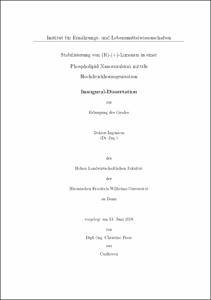| dc.description.abstract | In dieser Arbeit wird eine neuartige Phospholipid Nanoemulsion und ihr Herstellungsprozess detailliert untersucht und ihre Eignung, den instabilen Aromastoff (R)-(+)-Limonen physikalisch und chemisch zu stabilisieren, bewertet.
Ziel ist es dabei durch genaue Kenntnis des Herstellungsprozesses, der Eigenschaften der Nanoemulsion und ihres Einflusses auf das (R)-(+)-Limonen eine Stabilisierungsform für den Aromastoff zu finden, die es ermöglicht (R)-(+)-Limonen schonend und mit hoher Stabilität in wässrigen Lebensmitteln einsetzen zu können.
Der erste Teil der Arbeit befasst sich mit den physikalischen Eigenschaften der neuartigen Phospholipid Nanoemulsion, die in dieser Form noch nicht in der Literatur beschrieben ist. Neben einer makro- und mikroskopischen Strukturanalyse wird die Lagerstabilität in Abhängigkeit von Temperatur, Zeit und Verdünnungsgrad untersucht. Zur Beurteilung wird die Tropfengrößenverteilung, sowie das Zeta-Potenzial der Emulsion betrachtet.
Im zweiten Abschnitt der Arbeit wird der Hochdruckhomogenisationsprozess zur Herstellung der Nanoemulsion untersucht. Dabei wird der Einfluss der Strömungsverhältnisse im Homogenisator, der Temperatur, der dynamischen Viskositäten der Emulsionsphasen auf das Homogenisationsergebnis systematisch bewertet und optimiert.
In der so charakterisierte Nanoemulsion wird im dritten Teil das flüchtige Aroma (R)-(+)-Limonen kolloidal gelöst. Untersucht wird hierbei, ob sich aufgrund der Zugabe des Aromastoffes die physikalischen Eigenschaften der Emulsion, wie Mikrostruktur und Lagerstabilität verändern. Relevante Einflussgrößen sind hierbei Lagerdauer, Lagertemperatur, Verdünnungsgrad und Aromastoffkonzentration.
Gegenstand des folgenden Abschnittes ist der Einfluss der Nanoemulsion auf die Flüchtigkeit des (R)-(+)-Limonens in Abhängigkeit von der Temperatur, gemessen als Stoffmengenkonzentration im Gasraum über der Probe. Detailliert untersucht werden dabei die Funktion der Ölphase und des Emulgators Lecithin die Flüchtigkeit des Aromastoffes zu beeinflussen.
Im letzten Abschnitt schließlich wird auf die chemische Stabilität des (R)-(+)-Limonens in der Nanoemulsion eingegangen. Die qualitative und quantitative Analyse des Limonengehaltes und der seiner drei Abbauprodukte Carvon, Carveol und alpha-Terpineol werden zur Bewertung herangezogen. Die die Stabilität beeinflussenden Parameter sind dabei die Lagertemperatur, die Lagerdauer sowie die Lichtverhältnisse.
Die vorliegende Arbeit liefert somit umfassende Informationen über die Herstellung und Charakteristik der untersuchten Phospholipid Nanoemulsion zur Stabilisierung von Limonen, um es besser als Aromastoff in Lebensmitteln einsetzen zu können. Auf diese Weise wird ein Beitrag zum besseren Verständnis der Nanoemulsionstechnolgie bei Aromastoffen in der Lebensmitteltechnologie geleistet. Die Ergebnisse dieser Arbeit können als Grundlage für die Entwicklung neuer Applikationsformen von Limonen in Lebensmitteln dienen. Denkbar ist auch die Übertragung der gewonnenen Ergebnisse auf andere Terpene oder lipophile Aromastoffe.
Es werden sowohl das hohe Potenzial der Nanoemulsionstechnologie, als auch ihre Grenzen im Bereich der Lebensmitteltechnologie aufgezeigt und diskutiert. | en |
| dc.description.abstract | Stabilisation of (R)-(+)-limonen in a phospholipid nanoemulsion by means of high pressure homogenisation
This work deals with a detailed investigation of a new type of phospholipid nanoemulsion and its manufacturing process. Its suitability of physically and chemically stabilizing the sensitive flavouring (R)-(+)-limonen is assessed. The aim of this work is to find a new application form for the flavouring by means of a thorough knowledge of the manufacturing process, the characteristics of the nanoemulsion and its impact on (R)-(+)-limonen. The motivation behind this is to facilitate applications of highly stabilized (R)-(+)-limonen in food products with high water content.
The first part of the work provides an essential characterisation of the physical features of this new type of nanoemulsion. In addition to an analysis of the micro- and macro-structure of the emulsion, shelf-life with regard to temperature, time and dilution is examined. For a quantitative evaluation the distribution of the particle size and the zeta-potential are employed.
In the second part of this work the high pressure homogenisation process to manufacture the nanoemulsion is investigated. The influence of the hydrodynamic factors within the homogenisator, the working temperature, the dynamic viscosity of the inner and outer phases of the emulsion on the emulsifying result are systematically evaluated and optimized.
Having characterized the pure nanoemulsion the volatile flavouring (R)-(+)-limonen is colloidally dissolved in the disperse phase of the emulsion. Special attention is devoted to whether this entrapment changes the characteristics of the emulsion like micro-structure and shelf-life. Time of storage, temperature of storage and concentration of the flavouring are here the most important factors influencing the emulsion.
The following section is dedicated to the influence of the nanoemulsion on the volatility of (R)-(+)-limonen as a function of temperature. The volatility is measured as concentration of (R)-(+)-limonen in the headspace of the sample. Moreover the influence of the oil phase and of lecithin on the volatility of (R)-(+)-limonen are examined in detail.
Finally, in the last section the chemical stability of (R)-(+)-limonen entrapped in the nanoemulsion is examined. The qualitative and quantitative analysis of the concentration of (R)-(+)-limonen and the three degradation products carvon, carveol and alpha-terpineol is used for the evaluation. Storage temperature and time as well as light conditions are here the most important factors influencing the stability of (R)-(+)-limonen.
Summing up this work provides for the first time a comprehensive characterisation of the manufacture and features of the present phospholipid nanoemulsion and its potential to improve the stabilisation of (R)-(+)-limonen in food products. This provides an important basis for a more thorough understanding of the technology of nanoemulsions in regard to the stabilisation of flavour components. The results of this work can serve as starting point for the development of new forms of application for (R)-(+)-limonen in food.
It is very likely that these results can be applied to other terpenes or lipophilic flavour. The high potential of the technology of nanoemulsions as well as its limitation within the field of food technology are demonstrated and discussed. | en |






